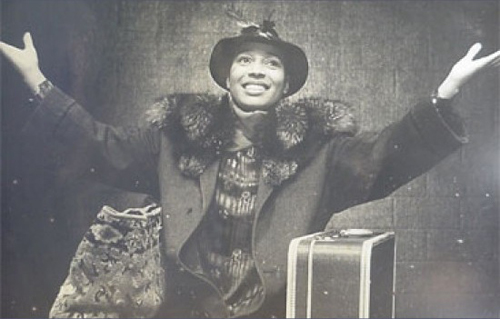Publisher's note: This well expressed article, by Diane Rufino, of what is so very evident in the face so much evidence to the contrary, will be posted in two chapters. Here is the first instalment published previously.
History teaches us
"I have no separate feeling about being an American citizen and colored. I am
merely a fragment of the Great Soul that surges within the boundaries. My country, right or wrong."-- Zora Neale Hurston
that the Ku Klux Klan was a violent organization aimed at terrorizing and intimidating former slaves. They operated as a secret society - a bunch of cowards with white gowns and masks, often carrying guns and a noose. We know the Klan's record of burning crosses and lynching negroes. We know its record on civil rights.
But the reason the Ku Klux Klan was formed was for a far different purpose. The KKK was founded in 1866 in Pulaski, Tennessee, by six former Confederate officers of the Civil War. These men approached distinguished General Nathan Bedford Forrest, one of the great heroes of the war, with the idea of a "police force" and asked for his "blessings," for he held the love and respect of the people. He gave his blessings, and in return, he was appointed their first leader. He was the first Grand Wizard. He would describe the organization as a social club and as "a protective political military organization." It was initially formed to help take care of poor Confederate widows. They also fought crime and "took care" of criminals. In other words, they basically restored order to the South, where for years there was none.
In an interview, General Forrest had this to say: "Yes, sir. It is a protective political military organization. I am willing to show any man the constitution of the society. The members are sworn to recognize the government of the United States. It does not say anything at all about the government of Tennessee. Its objects originally were protection against Loyal Leagues and the Grand Army of the Republic; but after it became general it was found that political matters and interests could best be promoted within it, and it was then made a political organization, giving its support, of course, to the democratic party.......Since its organization, the leagues have quit killing and murdering our people. There were some foolish young men who put masks on their faces and rode over the country, frightening negroes, but orders have been issued to stop that, and it has ceased. You may say, further, that three members of the Ku-Klux have been court-martialed and shot for violations of the orders not to disturb or molest people."
But soon, the Klan took on a more aggressive nature. It began to "persuade" freed blacks to assume their former status and to "scare" them into not voting or running for any elected office, as well as to harass and intimidate northern transplants, southern republicans, and other southerners who were supportive of the Union.
Controversy exists over whether Forrest actually played an active part in the organization and when he decided to sever his associate with it. Within a year or two of the Klan's founding, Forrest was asked if he was a member and he answered: "I am not, but am in sympathy and will co-operate with them. I know that they are charged with many crimes that they are not guilty of." In 1869 he asked the KKK to disband, stating: "being perverted from its original honorable and patriotic purposes, becoming injurious instead of subservient to the public peace."
Again, the KKK, as originally intended, did not target Negroes. In fact, Forrest gave many speeches and talks around the Memphis area from 1866, the year the KKK was founded, until 1874. Most of these speeches talked of peace, patriotism for the US Constitution, and trying to bring the country back together. On several occasions, he addressed black groups, to which he spoke these words: "We are born on the same soil, breathe the same air, live on the same land, and why should we not be brothers and sisters?" This is hardly the rhetoric of the Ku Klux Klan that it would later become -- a murderous hate group.
[Someone once asked Robert E. Lee to name the greatest soldier produced on either side during the war and he replied, "A man I have never seen, sir. His name is Forrest." William Tecumseh Sherman, General of the Army of the Potomac, who during the War called him "that devil Forrest," also had a high opinion of Forrest and said, "Forrest was the most remarkable man our Civil War produced on either side."]
As we all know, the KKK would continue on to spread into nearly every Southern state, launching a "reign of terror" against Republican leaders - black and white. It would become the "militant arm" of the Democratic Party. Forrest's grandson, Nathan Bedford Forrest II, a democrat and Grand Dragon of the KKK, wrote in the September 1928 edition of the Klan's The Kourier Magazine: "I have never voted for any man who was not a regular Democrat. My father never voted for any man who was not a Democrat. My grandfather was the head of the Ku Klux Klan in the Reconstruction days.... My great-grandfather was a life-long Democrat.... My great-great-grandfather was...one of the founders of the Democratic party."
In Dr. Eric Foner's book, A Short History of Reconstruction, he wrote: "In effect, the Klan was a military force serving the interests of the Democratic party, the planter class, and all those who desired the restoration of white supremacy. It aimed to destroy the Republican party's infrastructure, undermine the Reconstruction state, reestablish control of the black labor force, and restore racial subordination in every aspect of Southern life." [pg. 184]. He provides many accounts of the horrific acts of terror inflicted by Democrats on black and white Republicans. Professor Foner recounts one such act of terror: "Jack Dupree was a victim of a particularly brutal murder in Monroe County, Mississippi. Assailants cut his throat and disemboweled him, all within sight of his wife, who had just given birth to twins. He was 'president of a republican club' and known as a man who 'would speak his mind.'" [pp. 184-185].
After examining the abundant evidence concerning this violence, US Senator Roscoe Conkling concluded that the Democratic Party was determined to exterminate blacks in those States where Democratic supremacy was threatened. As a response to Democratic violence in the South, and in order to further secure the civil rights of blacks, Congress passed the 15th Amendment, explicitly guaranteeing voting rights for blacks.
The 15th Amendment - the final of the three post-war civil rights amendments was proposed by the US Congress on February 26, 1869. It was ratified by the states in 1870. It was the first-ever constitutional expansion of voting rights. Like the two previous civil rights amendments, it was passed along partisan lines. Not a single one of the 56 Democrats in Congress at that time voted for the 15th Amendment. Not a single Democrat, either from the North or the South, supported granting explicit voting rights to black Americans. Several fierce advocates of equal rights, like Senator Charles Sumner of Massachusetts, abstained from voting because it did not go far enough, in their opinion. They wanted the amendment to prohibit such arbitrary schemes which states might use to restrict black suffrage, such as literacy tests and poll taxes. Yet, despite the opposition from Democrats, the 15th Amendment did pass, thanks to the overwhelming support by Republican legislators. With the passage of this Amendment, leading abolitionist Wendell Phillips joyfully exclaimed, "We have washed color out of the Constitution!"
Reconstruction officially ended with the presidential election of 1876, which is discussed below. The newly-elected president, Rutherford B. Hayes, removed the remaining federal soldiers from the military districts and the southern states were once again free to resume their traditional state functions. Once the soldiers were gone, however, southern Democrats started mistreating the black people again with no fear of punishment because there were no soldiers to enforce the new laws, including the Civil Rights Act of 1866 and the civil rights amendments. As Republican influence was waning in the former confederacy, there was little political protection for the emancipated blacks from the Republican Party. It would only get worse in the years following the end of martial law.
The period that followed Reconstruction was known as "Redemption." Redeemers were part of the Southern Democrats who sought to oust the Republican coalition of freedmen, carpetbaggers, and scalawags and "redeem" the states from the Republicans back to the Democrats. Redemption would be complete before the election of 1880.
It wasn't until 1876 that the Southern Democrats were finally able to regain state political control. And it occurred thanks to the efforts of the Ku Klux Klan and other more formal paramilitary (terrorist/intimidation) groups affiliated with the Democratic Party, such as the White League and the Red Shirts. And it most specifically occurred thanks to the fraud and controversy which surrounded the 1876 election between Republican presidential candidate Rutherford B. Hayes and Democrat Samuel J. Tilden. By 1876, only 3 states - Louisiana, South Carolina, and Florida - were not yet "redeemed." The election ended up with 20 disputed electoral votes. On election night, as the votes were counted and the results circulated about the country by telegraph, it was clear that Tilden had won the popular vote. His final popular vote tally would be 4,288,546. The total popular vote for Hayes was 4,034,311. But the election was deadlocked. Tilden had 184 electoral votes, one vote short of the required majority. Four states - Oregon, South Carolina, Louisiana, and Florida - had disputed elections, and those states held 20 electoral votes.
A special commission, the Electoral Commission, was established by Congress to resolve those votes. There were 15 members - 7 members from the Democratic House, 7 members from the Republican Senate, and one member from the Supreme Court (who turned out to be a Republican). The commission voted along strict partisan lines to award all the disputed voted to Hayes, making him the winner by an electoral count of 185-184. Infuriated Democrats threatened to contest the election results until a deal was struck with Republicans. The Democrats would agree to support the commission's finding in exchange for removing federal troops from the South, naming a Southerner to the Hayes' cabinet, and allocating federal aid to the South. The Democratic Party regained power in South Carolina in 1877 and other states quickly followed. Thus was the quick rise and fall of the Republican Party in the South.
The 1880's began the period known as the Jim Crow era. This was the era where democratic state legislatures attempted to roll back the advances on behalf of freed slaves and other blacks by the Republicans. It was during this time that democratic state legislatures disfranchised most blacks and many poor whites through a combination of state constitutional amendments and electoral laws. They segregated blacks from white society and plantation owners found new ways to bind their former slaves as miserably-paid workers through sharecropping and other contractual arrangements. For all intents and purposes, many blacks found themselves in virtually the same position they had occupied before their emancipation.
In 1896, the Supreme Court heard the case of Plessy v. Ferguson, which addressed a Louisiana Jim Crow law that segregated rail cars. Homer Plessy, a black man, tried to board a "whites-only" train in Louisiana when the car designated for blacks was full. Once he boarded, he was forcibly removed and jailed. He sued the state, claiming the Louisiana segregation laws violated both his 13th and 14th Amendment rights. The Supreme Court, by a vote of 8-1, ruled that the 14th Amendment did not include a requirement that the races needed to be co-mingled and therefore upheld the doctrine of "Separate but Equal" when it came to facilities for blacks. Segregation was justified, providing the facilities and services were essentially equal. Plessy marked the beginning of a 58-year period where Jim Crow laws were largely unchallenged and condoned by the federal government. It not only perpetuated the white supremacist beliefs of the time, but also made it possible for states to make and enforce Jim Crow laws with impunity.
As admirable and inspiring as blacks were in the years following their liberation, a stark contrast in human nature was seen by the forces against them. Groups like the KKK and southern democrats behaved shamefully, deplorably, and inhumanely. Blacks began a distinguished, dignified, and long-overdue chapter in their history after the Civil War, but the opposite was true for the groups who acted in opposition to their freedom and to their rapid success. Many southern Democrats despised blacks and Republicans and they utilized every means possible to keep them from voting - including not only the use of devious and cunning means but also the direct use of violence. Here's the thing. After slavery was abolished, ALL freed slaves and other blacks were Republicans. [In the South, whites were mostly Democratic, but some could be Republican. Southern whites loyal to the antebellum South were mostly Democratic. Whites who sympathized with the North and wanted civil rights for blacks were Republican (scalawags). The worst thing you could be in the Reconstruction era South, and in the years that followed, was a Republican. And the most offensive Republican was a black one.
By 1900, democrats actually began actively to seek a repeal of the 14th and 15th Amendments. As democratic Senator Ben Tillman from South Carolina explained: "We made up our minds that the 14th and 15th Amendments to the Constitution were themselves null and void; that the civil rights acts of Congress were null and void; that oaths required by such laws were null and void." Prominent democratic leader A. W. Terrell of Texas said that the 15th Amendment guaranteeing black voting rights was "the political blunder of the century."
Democrats from both the North and the South agreed with Terrell and Tillman, and several asked for a repeal of the amendments. Louisiana Senator Samuel McEnery, who was one of those democrats, was confident that the effort would succeed. He even declared: "I believe that not a single southern Senator would object to such a move." Fortunately, the attempt failed.
In 1901, at the same time that democrats were seeking to roll back the civil rights amendments, republican President Teddy Roosevelt infuriated many democrats by inviting Booker T. Washington, a mulatto former slave who went on to become the leader of the Tuskegee Institute, to the White House. Washington became the first American of African descent to dine with a President at the White House. He served as an advisor to three republican US presidents - William McKinley, Roosevelt, and William Taft. Democrat President Woodrow Wilson, however, would not seek his counsel.
In 1915, the pro-Klan movie "Birth of a Nation" by D.W. Griffith was released to help beef up the ranks of the Ku Klux Klan. It was based on a book called "The Clansman" which was written by an avid racist, Thomas Dixon Jr. Dixon's text incorporated some material from Woodrow Wilson's book, "History of the American People" - particularly the part portraying the Ku Klux Klan in a sympathetic light. For example, it includes this piece from Wilson's book: "The white men were roused by a mere instinct of self-preservation until at last there had spring into existence a great Ku Klux Klan, a veritable empire of the South, to protect the Southern country." This section also made it into Griffith's movie. Democratic president Woodrow Wilson (1913-1921) held a private showing of this racist Klan-recruiting film at the White House. It was the first film to ever be shown at the White House. How racist was this film? It would become a major recruiting tool. It would be so successful that it helped the Klan to reach its peak membership of almost two million. Could the success in recruitment stem, perhaps, from an endorsement of the film from the highest office in the land?
President Woodrow Wilson was the first southerner to be elected to the White House since 1844 and only the second Democrat to be elected since Reconstruction. While he is respected as a scholar (serving as president of Princeton University) and viewed as a man of peace, especially in the public school system (he presented his "Fourteen Points of Peace" to Congress for establishing a lasting peace in Europe after WWI and wanted so badly to establish his particular version of a League of Nations), he was also regarded as an outright racist and a white supremacist. There is certainly an abundance of historical documentation to support this statement. While serving as the president of Princeton, Wilson discouraged black from applying to the university. And then when he served as Governor of New Jersey, he refused to confirm the hiring of blacks in his administration. As Wilson was known to say: "Segregation is not humiliating; it's a benefit!" As historians explain, he was a product of the pre- and post-war South and was brought up under the assumption at the time that the black race was inferior to the Saxon people. He was also bitter over the forced policies of Reconstruction on the southern states. He feared what might arise from a South "ruled by an ignorant and inferior race." Ironically, in the election of 1912, "an unprecedented number" of blacks left the Republican Party to cast their vote for Wilson, a Democrat because they were encouraged by his promises of support for minorities.
But once he took office however, he acted contrary to his campaign promises. Black leaders quickly noticed that he put segregationist white southern democrats in charge of many executive departments. He fired most of the blacks who held appointed posts within the federal government, and then permitted his segregationist cabinet appointees to establish official segregation policies in the Post Office, Treasury, and Navy, which until that time had been desegregated. (Many of these would remain segregated clear into the Truman administration, in the 1940's). Suddenly, under his authority, photographs were required of all applicants for federal jobs and new facilities were designed to keep the races working there separated (including separate toilets and lunch rooms). And then the democrat-controlled House proposed passed a bill making it a felony for any black person to marry a white person in Washington DC.
In the early 20th century, African-Americans needed a President to offer them hope. In many parts of the country, mostly in the South however, whites made them feel inferior. State laws enshrined a presumption of inferiority. And the Supreme Court had upheld those laws, thereby allowing the perpetuation of such laws and establishing cruel stereotypes. In the early 1860's, Abraham Lincoln was one such president who offered hope. In a time when it wasn't necessarily acceptable, he formed a strong friendship with a man of color - Frederick Douglass, a freed slave. Douglass was welcome at the White House and was often there to speak with the President. The mutual affection the men had for each other inspired Douglass to write these words in his memoirs after Lincoln was assassinated: "I have often said elsewhere what I wish to repeat here, that Mr. Lincoln was not only a great president, but a great man -- too great to be small in anything. In his company I was never in any way reminded of my humble origin, or of my unpopular color."
But Woodrow Wilson would not be that kind of president. His government policies would remind black Americans of their humble origin and of their unpopular color. It would remind them of the low expectations that the country still had of them. Robert Kennedy once spoke most eloquently about the importance of standing up for the rights of others. "Each time a man stands up for an ideal, or acts to improve the lot of others, or strikes out against injustice, he sends forth a tiny ripple of hope... and crossing each other from a million different centers of energy and daring those ripples build a current that can sweep down the mightiest walls of oppression and resistance."
The Jim Crow effectively ended in 1954 when the Supreme Court struck down school segregation in the
Brown v. Board of Education case. The case addressed de jure (legislative) segregation in public schools. Segregation was permissible at the time, supported by the
Plessy standard - "separate-but-equal." As long as facilities were fairly equal, the Supreme Court did not interpret the 14th Amendment to require a physical mixing of the races. With
Plessy v. Ferguson, the Supreme Court kept the spirit of Jim Crow alive by proclaiming from the highest legal tribunal that segregation was permissible under the 14th Amendment's notion of Equal Protection of the laws. But after looking at the particular case of public school segregation, Chief Justice Earl Warren, who delivered the Court's opinion, declared that the doctrine of "separate-but-equal" doctrine of Plessy had no place in public education. It was a personal opinion that he held strongly and which he apparently withheld during his Senate confirmation for the high court. He was appointed to the Supreme Court in 1953 by President Harry Truman just in time for oral arguments in the Brown case. As soon as the Senate confirmed him, he told his colleagues on the bench that he believed racial segregation violated the Constitution and that only if one considered African Americans inferior to whites could the practice be upheld.
Chief Justice Earl Warren was a Republican. In fact, he ran as a Republican for the seat of Governor of California, which he won. He served three terms.
Brown v. Board of Education, 347 U.S. 483 (1954), was a landmark United States Supreme Court case in which the Court declared state laws establishing separate public schools for black and white students unconstitutional. The decision overturned the
Plessy v. Ferguson decision of 1896 which allowed state-sponsored segregation. Handed down on May 17, 1954, the Warren Court's unanimous (9–0) decision stated that "separate educational facilities are inherently unequal." As a result, de jure racial segregation was ruled a violation of the Equal Protection Clause of the Fourteenth Amendment of the United States Constitution. This ruling paved the way for integration and was a major victory of the civil rights movement. It is said that the case was decided by the results of a "doll test."
The doll test at the heart of the
Brown decision was designed by Mamie and Kenneth Clark, African-American (husband and wife) psychologists, to study the effects of segregation and racism on the self-esteem of black children. In the test, black children were put in a room with two types of dolls - a white doll with blonde hair and a brown doll with black hair - and then observed to see which dolls they preferred to play with. The children were then asked questions inquiring as to which doll is the nice doll, which one looks bad, which one has the nicer color, etc. (Mamie used a similar test as the basis of her master's thesis). All the black children preferred the white dolls. The findings of the Clarks' doll test were submitted to the Supreme Court as evidence of the negative implessyact of segregation on the mental and psychological status of black schoolchildren. The Clarks concluded that the children felt the impact of segregation and felt a sense of inferiority.
The key holding of the Court was that, even if segregated black and white schools were of equal quality in facilities and teachers, segregation by itself was harmful to black students and unconstitutional. They found that a significant psychological and social disadvantage was given to black children from the nature of segregation itself (drawing on the "doll study" research). This aspect was vital because the question was not whether the schools were "equal," which under the
Plessy standard, they should have been, but whether the doctrine of "separate-but-equal" was constitutional with respect to public education. The justices answered with a strong "no." Chief Justice Warren wrote:
"Does segregation of children in public schools solely on the basis of race, even though the physical facilities and other "tangible" factors may be equal, deprive the children of the minority group of equal educational opportunities? We believe that it does... Segregation of white and colored children in public schools has a detrimental effect upon the colored children. The impact is greater when it has the sanction of the law, for the policy of separating the races is usually interpreted as denoting the inferiority of the negro group. A sense of inferiority affects the motivation of a child to learn. Segregation with the sanction of law, therefore, has a tendency to [retard] the educational and mental development of negro children and to deprive them of some of the benefits they would receive in a racially integrated school system... We conclude that, in the field of public education, the doctrine of "separate but equal" has no place. Separate educational facilities are inherently unequal. Therefore, we hold that the plaintiffs and others similarly situated for whom the actions have been brought are, by reason of the segregation complained of, deprived of the equal protection of the laws guaranteed by the Fourteenth Amendment."
























